#plutoflyby
Explore tagged Tumblr posts
Text
Solar System 10 Things: Looking Back at Pluto
In July 2015, we saw Pluto up close for the first time and—after three years of intense study—the surprises keep coming. “It’s clear,” says Jeffery Moore, New Horizons’ geology team lead, “Pluto is one of the most amazing and complex objects in our solar system.”
1. An Improving View

These are combined observations of Pluto over the course of several decades. The first frame is a digital zoom-in on Pluto as it appeared upon its discovery by Clyde Tombaugh in 1930. More frames show of Pluto as seen by the Hubble Space Telescope. The final sequence zooms in to a close-up frame of Pluto taken by our New Horizons spacecraft on July 14, 2015.
2. The Heart
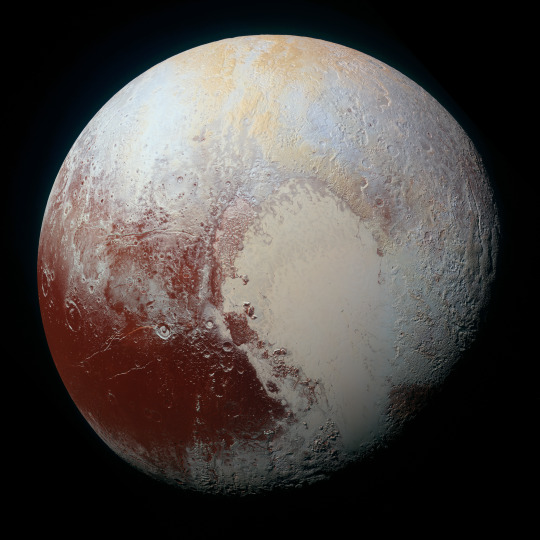
Pluto’s surface sports a remarkable range of subtle colors are enhanced in this view to a rainbow of pale blues, yellows, oranges, and deep reds. Many landforms have their own distinct colors, telling a complex geological and climatological story that scientists have only just begun to decode. The image resolves details and colors on scales as small as 0.8 miles (1.3 kilometers). Zoom in on the full resolution image on a larger screen to fully appreciate the complexity of Pluto’s surface features.
3. The Smiles
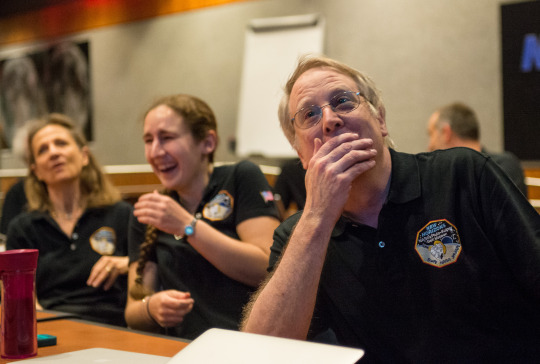
July 14, 2015: New Horizons team members Cristina Dalle Ore, Alissa Earle and Rick Binzel react to seeing the spacecraft's last and sharpest image of Pluto before closest approach.
4. Majestic Mountains
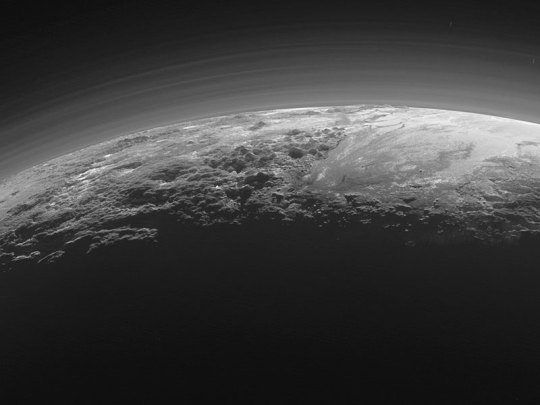
Just 15 minutes after its closest approach to Pluto, the New Horizons spacecraft captured this near-sunset view of the rugged, icy mountains and flat ice plains extending to Pluto's horizon. The backlighting highlights more than a dozen layers of haze in Pluto's tenuous atmosphere. The image was taken from a distance of 11,000 miles (18,000 kilometers) to Pluto; the scene is 780 miles (1,250 kilometers) wide.
5. Icy Dunes
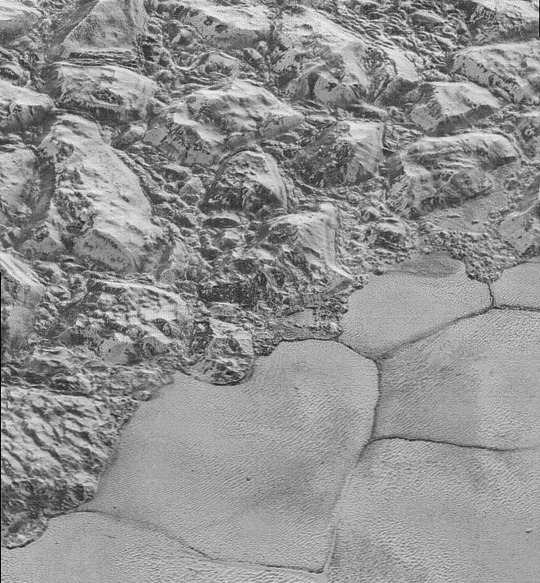
Found near the mountains that encircle Pluto’s Sputnik Planitia plain, newly discovered ridges appear to have formed out of particles of methane ice as small as grains of sand, arranged into dunes by wind from the nearby mountains.
6. Glacial Plains
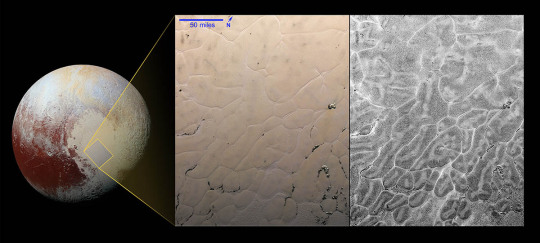
The vast nitrogen ice plains of Pluto’s Sputnik Planitia – the western half of Pluto’s “heart”—continue to give up secrets. Scientists processed images of Sputnik Planitia to bring out intricate, never-before-seen patterns in the surface textures of these glacial plains.
7. Colorful and Violent Charon
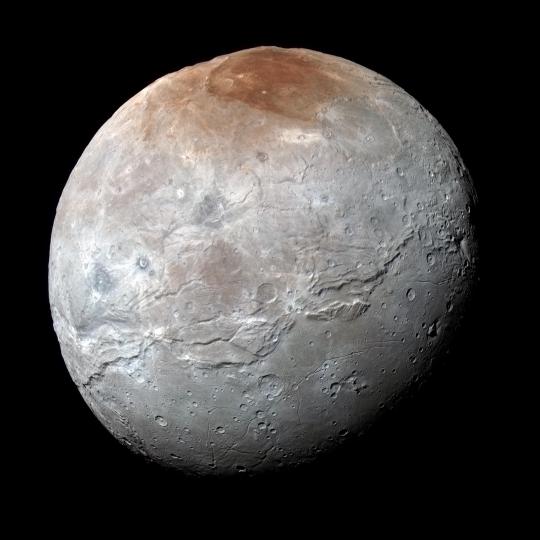
High resolution images of Pluto’s largest moon, Charon, show a surprisingly complex and violent history. Scientists expected Charon to be a monotonous, crater-battered world; instead, they found a landscape covered with mountains, canyons, landslides, surface-color variations and more.
8. Ice Volcanoes
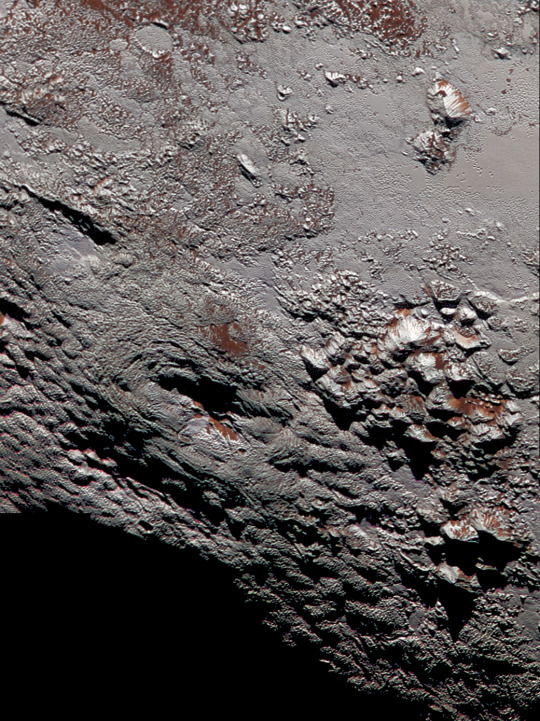
One of two potential cryovolcanoes spotted on the surface of Pluto by the New Horizons spacecraft. This feature, known as Wright Mons, was informally named by the New Horizons team in honor of the Wright brothers. At about 90 miles (150 kilometers) across and 2.5 miles (4 kilometers) high, this feature is enormous. If it is in fact an ice volcano, as suspected, it would be the largest such feature discovered in the outer solar system.
9. Blue Rays
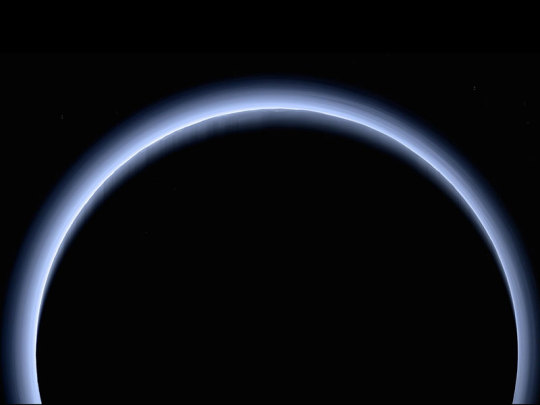
Pluto's receding crescent as seen by New Horizons at a distance of 120,000 miles (200,000 kilometers). Scientists believe the spectacular blue haze is a photochemical smog resulting from the action of sunlight on methane and other molecules in Pluto's atmosphere. These hydrocarbons accumulate into small haze particles, which scatter blue sunlight—the same process that can make haze appear bluish on Earth.
10. Encore
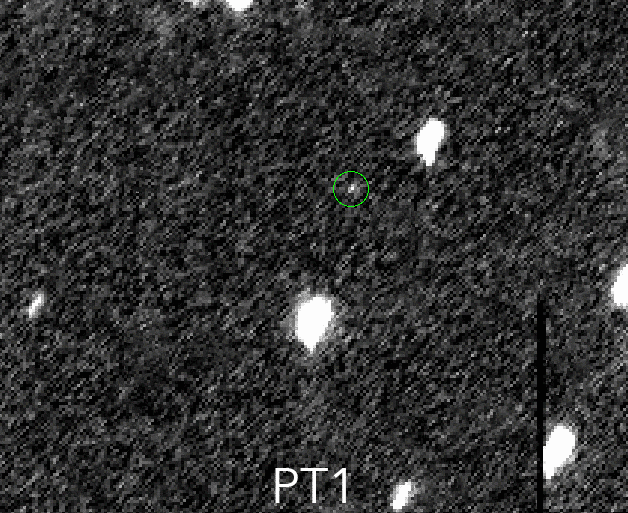
On Jan. 1, 2019, New Horizons will fly past a small Kuiper Belt Object named MU69 (nicknamed Ultima Thule)—a billion miles (1.5 billion kilometers) beyond Pluto and more than four billion miles (6.5 billion kilometers) from Earth. It will be the most distant encounter of an object in history—so far—and the second time New Horizons has revealed never-before-seen landscapes.
Make sure to follow us on Tumblr for your regular dose of space: http://nasa.tumblr.com.
#NASA#space#new horizons#spacecraft#pluto#plutoflyby#science#dwarf planet#kuiper belt#exploration#solar system#universe#discovery
5K notes
·
View notes
Photo

Plutão em cores falsas para revelar sua topografia. A região azul é a planície Sputnik, uma cratera de impacto para onde fluiu nitrogênio líquido. . Pluto in false colors to reveal its topography. The blue region is Sputnik Planitia, an impact basin where liquid nitrogen flew into. . Credit: NASA/J. T. Keane . #pluto #plutao #plutoflyby #sputnik #sputnikplanitia #topography #topografia #planice #planitia #astronomy #astronomia #observatoriog1 #astrogram
#astrogram#planitia#topografia#plutao#planice#observatoriog1#pluto#sputnikplanitia#sputnik#topography#plutoflyby#astronomia#astronomy
102 notes
·
View notes
Photo

Pluto’s Bladed Terrain: https://apod.nasa.gov/apod/ap171005.html.
“Imaged during the New Horizons spacecraft flyby in July 2015, Pluto's bladed terrain is captured in this close-up of the distant world. The bizarre texture belongs to fields of skyscraper-sized, jagged landforms made almost entirely of methane ice, found at extreme altitudes near Pluto's equator. Casting dramatic shadows, the tall, knife-like ridges seem to have been formed by sublimation. By that process, condensed methane ice turns directly to methane gas without passing through a liquid phase during Pluto's warmer geological periods. On planet Earth, sublimation can also produce standing fields of knife-like ice sheets, found along the high plateau of the Andes mountain range. Known as penitentes, those bladed structures are made of water ice and at most a few meters tall.”
1 note
·
View note
Audio
(Volkor X)
4 notes
·
View notes
Photo

At about 7:50am in 2015, I created this happy version of #Pluto that made people around the world come together to celebrate the @NASA #newhorizons mission. #plutoflyby
0 notes
Photo

Los orígenes de las cuchillas gigantes de hielo encontradas en Plutón por la nave espacial New Horizons eran un misterio para los científicos ... ¡pero no más! Ahora creen que las estructuras están hechas casi enteramente de hielo metano, probablemente formado como un tipo específico de erosión que llevaba sus superficies. Estas crestas geológicas irregulares se encuentran en las alturas más altas en la superficie de Plutón, cerca de su ecuador, y puede volar muchos cientos de pies en el cielo - tan alto como un rascacielos de la ciudad de Nueva York. Estructuras similares se pueden encontrar en los campos de nieve de alta altitud a lo largo del ecuador de la Tierra, aunque en una escala muy diferente a las hojas de Plutón. Las estructuras terrestres, llamadas penitentes, son formaciones de nieve a sólo unos pocos metros de altura, con sorprendentes similitudes con el terreno de gran amplitud en Plutón. Desliza para ver la comparación de la Tierra! #bywilsonpc #tudclnlimited #nasa #space #pluto #newhorizons #spacecraft #flyby #plutoflyby #ice #jaggad #terrain #structures #equator #solarsystem #earth #formations #dwarfplanet #picoftheday #skyscraper
#space#bywilsonpc#spacecraft#structures#jaggad#tudclnlimited#plutoflyby#dwarfplanet#solarsystem#flyby#terrain#equator#formations#nasa#skyscraper#earth#ice#picoftheday#newhorizons#pluto
0 notes
Text
Twee jaar na New Horizon's #plutoflyby komt NASA met nieuwe kaarten van Pluto en Charon
Twee jaar na New Horizon’s #plutoflyby komt NASA met nieuwe kaarten van Pluto en Charon
Kaarten van Pluto en Charon. Credit: NASA/Johns Hopkins University Applied Physics Laboratory/Southwest Research Institute/Lunar and Planetary Institute
Op 14 juli 2015 vloog NASA’s ruimteverkenner New Horizons langs Pluto, z’n maan Charon en de andere kleinere manen. Prcies twee jaar later, vrijdag 14 juli 2017, kwam de NASA met nieuwe gedetailleerde kaarten van het oppervlak van Pluto en…
View On WordPress
0 notes
Photo

🌞#roadtrip #solarsystem #pluto #image #funny #pic #part5 #planets #plutoflyby #space
0 notes
Text
That Time We Flew Past Pluto…
Two years ago today (July 14), our New Horizons spacecraft made its closest flyby of Pluto…collecting images and science that revealed a geologically complex world. Data from this mission are helping us understand worlds at the edge of our solar system.

The spacecraft is now venturing deeper into the distant, mysterious Kuiper Belt…a relic of solar system formation…to reach its next target. On New Year’s Day 2019, New Horizons will zoom past a Kuiper Belt object known as 2014 MU69.

The Kuiper Belt is a disc-shaped region of icy bodies – including dwarf planets such as Pluto – and comets beyond the orbit of Neptune. It extends from about 30 to 55 Astronomical Units (an AU is the distance from the sun to Earth) and is probably populated with hundreds of thousands of icy bodies larger than 62 miles across, and an estimated trillion or more comets.
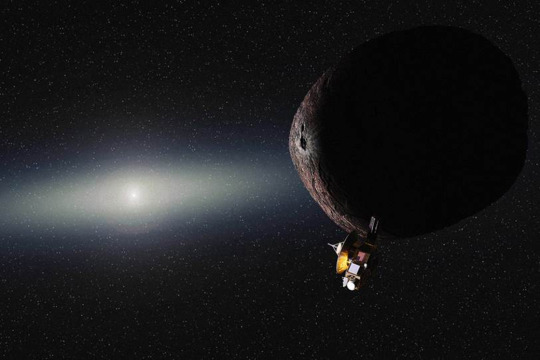
Nearly a billion miles beyond Pluto, you may be asking how the spacecraft will function for the 2014 MU69 flyby. Well, New Horizons was originally designed to fly far beyond the Pluto system and explore deeper into the Kuiper Belt.

The spacecraft carries extra hydrazine fuel for the flyby; its communications system is designed to work from beyond Pluto; its power system is designed to operate for many more years; and its scientific instruments were designed to operate in light levels much lower than it will experience during the 2014 MU69 flyby.
What have we learned about Pluto since its historic flyby in 2015?
During its encounter, the New Horizons spacecraft collected more than 1,200 images of Pluto and tens of gigabits of data. The intensive downlinking of information took about a year to return to Earth! Here are a few things we’ve discovered:
Pluto Has a Heart

This image captured by New Horizons around 16 hours before its closest approach shows Pluto’s “heart.” This stunning image of one of its most dominant features shows us that the heart’s diameter is about the same distance as from Denver to Chicago. This image also showed us that Pluto is a complex world with incredible geological diversity.
Icy Plains

Pluto’s vast icy plain, informally called Sputnik Planitia, resembles frozen mud cracks on Earth. It has a broken surface of irregularly-shaped segments, bordered by what appear to be shallow troughs.
Majestic Mountains

Images from the spacecraft display chaotically jumbled mountains that only add to the complexity of Pluto’s geography. The rugged, icy mountains are as tall as 11,000 feet high.
Color Variations

This high-resolution enhanced color view of Pluto combines blue, red and infrared images taken by the New Horizons spacecraft. The surface of Pluto has a remarkable range of subtle color variations. Many landforms have their own distinct colors, telling a complex geological and climatological story.
Foggy Haze and Blue Atmosphere

Images returned from the New Horizons spacecraft have also revealed that Pluto’s global atmospheric haze has many more layers than scientists realized. The haze even creates a twilight effect that softly illuminates nightside terrain near sunset, which makes them visible to the cameras aboard the spacecraft.
Water Ice
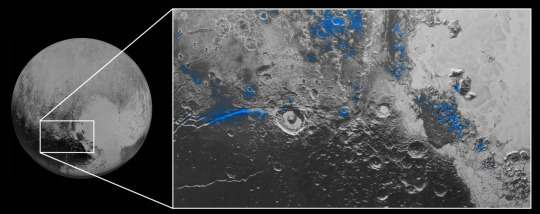
New Horizons detected numerous small, exposed regions of water ice on Pluto. Scientists are eager to understand why water appears exactly where it does, and not in other places.
Stay updated on New Horizons findings by visiting the New Horizons page. You can also keep track of Pluto News on Twitter via @NASANewHorizons.
Make sure to follow us on Tumblr for your regular dose of space: http://nasa.tumblr.com
#nasa#space#pluto#newhorizons#plutoflyby#solarsystem#dwarfplanet#exploration#science#discovery#kuiperbelt#mu69
4K notes
·
View notes
Photo


A set of Facebook memories from july 14 shared in ‘15 and ‘14
[Don Rozanski]
i still call it a planet.
[NASA -National Aeronautics and Space Administration]
Pluto has sent a love note back to Earth via our New Horizons spacecraft, which has traveled more than 9 years and 3+ billion miles. This is the last and most detailed image of Pluto sent to Earth before the moment of closest approach, which was at 7:49 a.m. EDT today. Images from the #PlutoFlyby will be processed and released on Wednesday, July 15. More to come!
July 14, 2015 • Facebook
[Don Rozanski]
[better than a movie screen]
@ObservingSpace: Auroras over Northern Canada http://apod.nasa.gov/apod/ap140714.html #apod #aurora #yellowknife#canada #orion
7/14/14, 12:17 AM (on twitter)
July 14, 2014 • Facebook
and a memory shared by my sister Barbie from ‘16 (and tonight a firefly that got inside her house landed on my arm while typing at the iMac)
[Barbie Morales]
I love sitting on my deck at night watching the fireflies. It's so peaceful. It takes me back to when my brother Don Rozanski, Peter Bruinekool, Kelli Bruinekool Hansen and I would be in the back yard at Aunt Sharon Bruinekool catching them and just having fun outside. That's a memory I will never forget. ❤️
July 14, 2016 • Facebook
6 notes
·
View notes
Text
After a decade flying through our solar system, @NASANewHorizons made its closest approach to Pluto in the #PlutoFlyby today in 2015. Next up: a Kuiper Belt object the spacecraft will explore on Jan. 1, 2019 in the farthest planetary encounter in history: https://go.nasa.gov/2KXQttu pic.twitter.com/nfHopEiML9
After a decade flying through our solar system, @NASANewHorizons made its closest approach to Pluto in the #PlutoFlyby today in 2015. Next up: a Kuiper Belt object the spacecraft will explore on Jan. 1, 2019 in the farthest planetary encounter in history: https://go.nasa.gov/2KXQttu pic.twitter.com/nfHopEiML9

from Ricky Schneiderus Curation https://twitter.com/NASA/status/1018150882326777861
0 notes
Link
0 notes
Photo

#DisneyChristmas #Workshop #santa #Goofy #DonaldDuck #MickeyMouse #WaltDisney #PlutoFlyby #disneyonclassic #ThriftyGal7 www.etsy.com/shop/ThriftyGal7
0 notes
Text
Petition to make pluto a planet...
https://www.change.org/p/international-astronomical-union-declare-pluto-a-planet-plutoflyby
0 notes
Video
(vía https://www.youtube.com/watch?v=AcI0Qg6tf2Q)
NASA Pluto: New definition of the planet would make 100 celestial bodies.
planet, and grant planetary status to the Earth’s moon and more than 100 other celestial bodies in our solar system. Kirby Runyon of Johns Hopkins University is reigniting the debate over Pluto’s planetary...
#space #science #Earth #ISS #astrology #MediumCoeli #Ascendant #AbanTech #Capricorn #PlutoFlyby #Cosmic #Runyon #release #PlanetPluto #NASAPluto #OrbitPluto #NewDefinition #Pluto #Planet
0 notes
Photo

A Facebook memory shared on this day in History
[Don Rozanski shared NASA - National Aeronautics and Space Administration’s photo]
i still call it a planet.
[NASA - National Aeronautics and Space Administration]
Pluto has sent a love note back to Earth via our New Horizons spacecraft, which has traveled more than 9 years and 3+ billion miles. This is the last and most detailed image of Pluto sent to Earth before the moment of closest approach, which was at 7:49 a.m. EDT today. Images from the #PlutoFlyby will be processed and released on Wednesday, July 15. More to come!
July 14, 2015 • Facebook
and then a memory from ‘09 on this day with a visit to nordaggio’s coffee in Tulsa, Oklahoma with my daughter and friend:
Kelsey. Don. Jose. Nord’s. Yeah.
July 14, 2009 • Facebook
and Today’s date of 7.14 when viewed as 14.7 reminds me of the odometer reading of 147k miles on my old Lumina on a friday in History, the last day of work at Love envelopes, inc. in Tulsa back in january of ‘06
which reminds me again of the nature of a poem typewritten on this day 7 years ago back in 2010 which became #14 in that month of july, coinciding with day 14:
14. one day you will
sometimes i talk a lot… inaudibly can you hear? can you see me smiling? can you feel these words coming to life a kiss on your lips good morning & goodnight?
you don’t have to see my mouth move to know what i’m saying is true you don’t have to feel my touch to know the power of true love
you’ve heard my story you’ve listened to my song messages in the sky through your window in rain or shine all day long words typed on every line of our rainbow
and as i sit here now, i’m just tryin’ to say a few of the favorite things on my mind today with your ear turned intently, evidently when we’re both smiling in secret it makes my day
you don’t have to see my mouth move to know what i’m saying is true you don’t have to feel my touch to know the power of true love but one day you will…
(july 14, ‘10) dfroza
0 notes